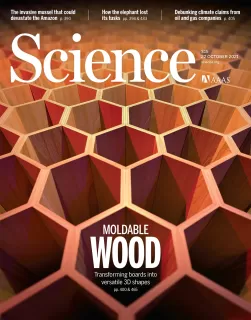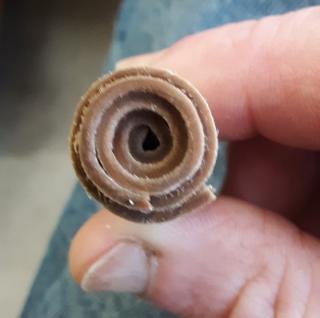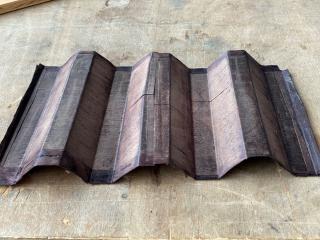# Moldable Wood: Endless Possibilities
Angela Aguero
Forest Products Laboratory
December 14, 2021

Oct. 22, 2021, cover of Science Magazine
Do you remember learning origami as a kid?
From simple sheets of paper, you could create anything – flowers, animals, houses, furniture. The possibilities were endless.
Now think about what you could do with wood instead of paper – wood that is easily manipulated, but far stronger than paper.
Foldable, moldable, “origami” wood is now a reality – and it is ideal for 3-dimensional building materials, furnishings, and vehicular interiors, to name only some of the possibilities.
The article “Lightweight Strong Moldable Wood Via Cell Wall Engineering as a Sustainable Structural Material,” whose coauthors include Forest Products Laboratory research scientists, made the cover of Science Magazine this year. And the new technology is causing a sensation.
“In this work,” the article states, “we demonstrate how cell wall engineering can render wood foldable and moldable while simultaneously improving its mechanical properties – endowing wood with a structural versatility previously limited to plastics and metals.”
Junyong Zhu – or JY, as he is known among his colleagues – is a scientist at FPL who specializes in fiber and chemical sciences. One of his many research specialties includes the chemical modification of wood for advanced applications.

A fully foldable wood veneer after cell engineering. Photo by FPL Fiber and Chemical Research Technician Rollie Gleisner, who also conducted delignification experiments in this study.
“The seemingly impossible task of molding solid wood is based on an understanding of fiber,” JY explained. “Hornification (increased hydrogen bonding) of delignified wood takes place after drying, making wood cells shrink. The partial reversibility of the hornification for mildly dried wood, after a ‘water shock’ to make the shrunken wood cells partially recover, results in easily foldable wood.
“Perhaps most remarkably, moldable wood is strong, due to its densification by drying,” added JY. Indeed, the article in Science features a photograph of a 3,500-pound hatchback sedan rolling over a molded wood structure – in this case, a honeycomb design, which emerges none the worse for wear.
The beauty and warmth of wood, in contrast to plastic and metal, are appealing to human sensibilities. At the same time, wood is environmentally friendly on many levels.
Wood, of course, is inherently sustainable. Its use stores carbon and does not release it into the atmosphere nor produce polluting waste, in contrast to the processing of metal and plastic materials. With this new moldable technology, we will be able to replace these less-desirable materials and use more wood in our daily lives.

Densified beechwood veneer rolled over aluminum rod mandrel. Photo by Marco Lo Ricco.
The final products of moldable wood are resistant to humidity and fungus.
Here is where Microbiologist Vina Yang, who works on the durability and wood protection research team at Forest Products Laboratory, comes in. “My work on this paper was focused on fungal degradation on 3D wood to ascertain its durability and sustainability,” said Vina. “Any type of modified wood product involves the study of its properties, how to protect wood from fungal decay, or how recyclable the product is. This 3D-engineered wood is durable and less degradable by decay fungi than natural wood.”
Tasked with developing structural applications for the reconstituted wood materials of this research, Forest Products Laboratory Research General Engineer Marco Lo Ricco formed densified beechwood and birchwood veneers into a laminated tube and corrugated decking.
“The dense packing of cellulose fibers makes this material stiff, like an aluminum alloy, but with less thermal heat transfer,” says Marco.
While creating prototypes, Marco observed many manufacturing challenges and opportunities. “For example,” he explained, “veneers must be formed wet; therefore, shrinkage must be controlled while setting the laminating adhesives. Also, the differences in stiffness and strength are relative to parallel and perpendicular fiber directions and are more accentuated than untreated wood veneers.”

Densified birchwood veneer hot-pressed into corrugated decking using aqueous phenolic adhesive. Photo by Marco Lo Ricco.
Based on this unique formability and high stiffness, Marco is investigating ways to manufacture 3D building components in order to advance the use of wood materials for specialized building applications that value high stiffness, shallow member sizes, and reduced thermal bridging between interior and exterior spaces.
By reimaging wood properties, the versatility of fabrication wi